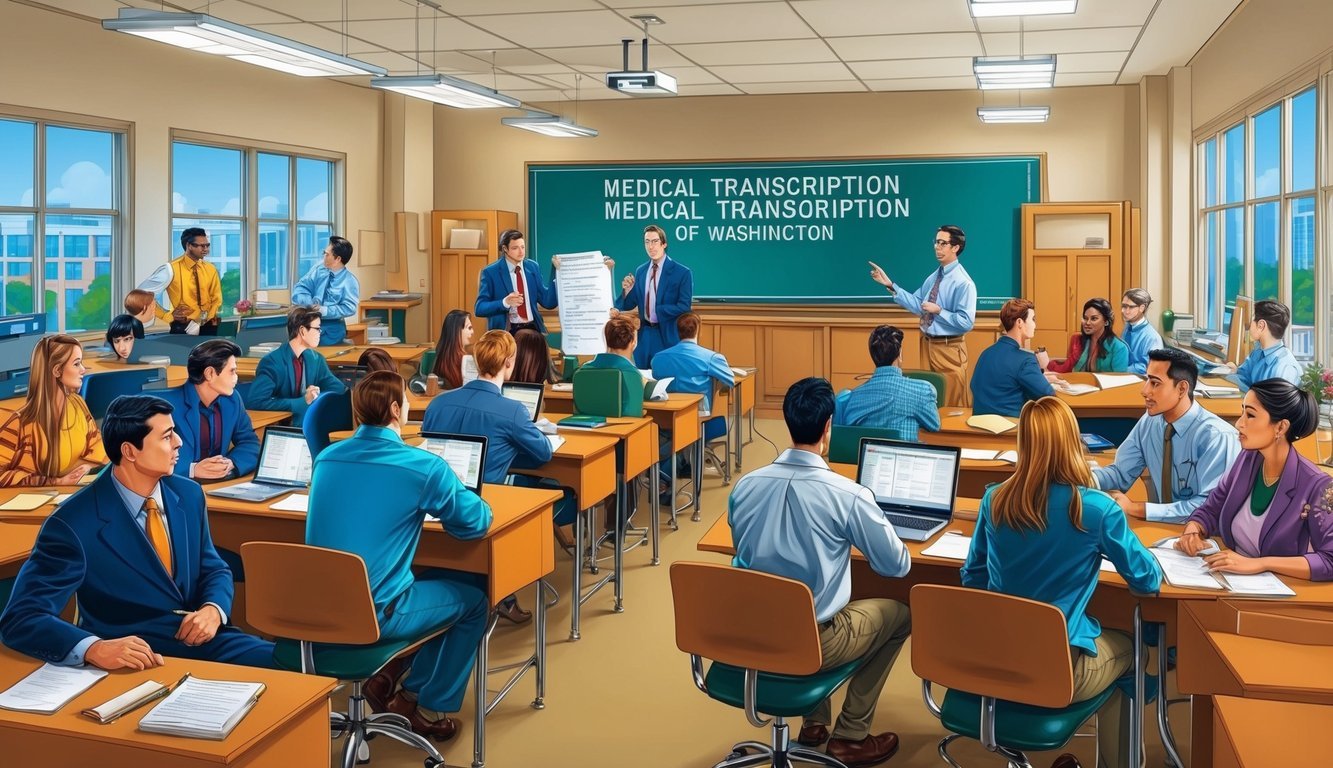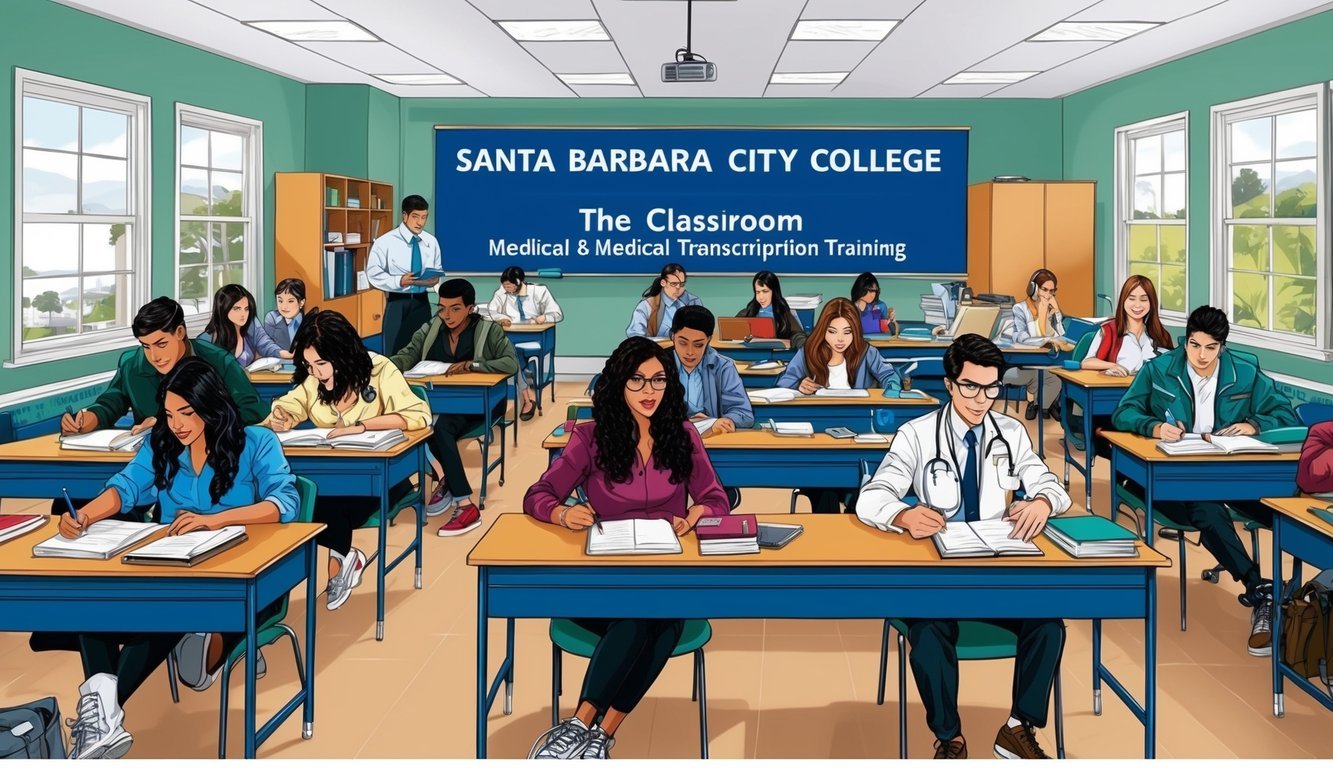“`xml
Thinking of diving into a medical transcription career? This gig allows you to work from home and play an essential role in helping doctors and nurses keep accurate records.
Plus, you won’t have to sit in a classroom for years to get started.

You’ll find plenty of online programs that can teach you to be a medical transcriptionist.
These courses typically take between 6 months and 2 years to complete, with costs ranging from $1,000 to $5,000.
You’ll pick up skills like fast typing, medical terminology, and understanding specialized software.
Once you’re trained, you can hunt for jobs at hospitals, doctors’ offices, or even start your own freelance business.
1) University of Washington

Want to kick off your medical transcription journey? The University of Washington is here to help! They’ve got two fantastic programs to prep you for the job market.
Start with their Medical Transcription Associate Program.
This course gives you real experience with actual medical reports, where you’ll transcribe hundreds of documents from both inpatient and outpatient settings.
If you’re eager for more, check out the Medical Transcription Expert Program.
You’ll tackle more complex documents like physical exams and progress notes, plus you’ll get practice with speech recognition editing.
By the end of these courses, you’ll be well-equipped to handle a variety of medical documentation challenges like a pro.
Both programs start with the basics, covering medical terminology and anatomy before jumping into transcription techniques.
This solid foundation sets you up for success.
And the best part? You can learn online, so you can fit classes into your busy lifestyle, whether you’re a parent on the go or holding down a full-time job.
2) Drexel University

If you’re after a solid medical transcription program, Drexel University might be just what you’re looking for.
They’ve got some exciting options that can set you up for success in the field.
Drexel offers an evening post-baccalaureate premedical program.
It’s part of their Drexel Pathway to Medical School, which sounds fancy but is incredibly practical.
You’ll learn from fantastic instructors, and with a 1.5:1 faculty-student ratio, you’ll get tons of personal attention.
Need transcripts after you finish? No problem! Drexel makes it easy to order them online.
You can grab a PDF or a paper form, whatever works for you.
Thinking long-term? Drexel also has some early assurance programs for their medical school, showing they’re committed to helping students build their healthcare careers.
3) Purdue University Global

Curious about a solid medical transcription program? Purdue University Global has you covered with their online medical billing and coding certificate program.
This course teaches you how to submit medical claims, process bills, and navigate computerized billing systems—right from your couch!
You’ll learn about medical terminology, anatomy, and physiology, plus get hands-on practice with coding systems used in healthcare settings.
The cherry on top? This program gets you ready for certification exams in the field, so you can jump straight into your new career.
If you want to go further, Purdue Global offers plenty of other health sciences degree programs.
Whether you’re aiming for healthcare administration or public health, they have options that can broaden your horizons.
And remember, you can always request a transcript if you want to show off your hard-earned success to future employers.
4) Santa Barbara City College

Santa Barbara City College offers a commendable medical transcription program, where you can earn an Associate of Science in Health Information Technology.
This degree prepares you for an exciting career at the intersection of healthcare and technology.
Pressed for time? Consider the Medical Coding Specialist Certificate instead—it’s an ideal choice if you’re more inclined toward coding medical records.
In addition to that, the college has rolled out a Healthcare Data Analytics program, focusing on using data to enhance healthcare outcomes.
Worried about tuition? If you’re a California resident, you’re looking at only $46 per unit—a steal for quality education!
The cherry on top? Santa Barbara City College is accredited, with their Health Information Management program recognized through 2027.
This means your degree will be highly regarded.
And the location? It’s right on Cliff Drive in beautiful Santa Barbara.
Imagine learning with ocean views! How’s that for motivation?
Understanding Medical Transcription
Medical transcription is all about turning doctors’ voice recordings into clear written documents.
It’s a key process to ensure medical records are up-to-date and accurate.
Let’s break down what medical transcriptionists do and why it matters.
The Role of a Medical Transcriptionist
You might be asking yourself, “What exactly does a medical transcriptionist do, anyway?” Well, they listen to voice recordings from doctors and other healthcare professionals, then turn those recordings into clear, accurate medical reports.
These folks need to know a ton of medical terms and be able to understand various accents and speaking styles.
It’s not just about typing—it’s also about fixing grammar and clarifying any confusing parts.
They work in hospitals, clinics, and sometimes right from their homes.
Using specialized software, they get their work done more efficiently and accurately.
The Importance of Accuracy and Efficiency
Getting it right is crucial in medical transcription.
One tiny mistake can lead to big problems for a patient’s care.
You need to be quick, too.
Doctors and nurses often need those reports ASAP to make important decisions.
It’s a juggling act between speed and accuracy.
Good transcriptionists double-check their work.
They look up any terminology they’re unsure about to ensure patient safety and keep the right treatments flowing.
Efficiency is key because hospitals and clinics manage a ton of patients daily.
Quick, precise transcripts help maintain smooth operations.
Career Opportunities in Medical Transcription
Medical transcription offers a range of job opportunities in the healthcare field.
You can work in different settings or even from home, giving you flexibility and potential for growth.
Work Environments
You’ll find jobs in hospitals, clinics, and doctors’ offices.
Many medical transcriptionists work for larger healthcare systems, while others join transcription companies that serve multiple clients.
Insurance companies and law firms often hire transcriptionists for medical records, and there’s plenty of opportunity in research facilities or government health agencies.
As you gain experience, your skills can open doors to roles beyond basic transcription.
You could become a quality assurance editor or team lead, or even move into healthcare documentation training or management positions.
Remote Work Potential
Working from home is a coveted perk in medical transcription.
Many employers offer remote positions, meaning you can skip the daily commute.
You’ll need a quiet space and reliable internet.
Most companies provide the necessary software, but you might need equipment like a foot pedal for playback control.
Remote work often means you can choose your hours, as long as you’re hitting your deadlines.
It’s perfect if you’ve got other commitments or prefer a non-traditional work setting.
Just keep in mind that remote jobs might come with production quotas.
You’ll need to be self-motivated and manage your time effectively to thrive.
Frequently Asked Questions
If you’re looking to break into medical transcription, you probably have questions about training programs, online options, and job opportunities.
Let’s tackle some common queries together to help you make smart choices for your career.
Which medical transcription schools have the best reputation?
The University of Washington is widely recognized for its outstanding medical transcription program.
Drexel University and Purdue University Global also offer well-regarded courses in this field.
Can you recommend any medical transcription courses available online?
If you’re looking for an online option, check out Penn Foster’s training program.
It prepares you for RHDS certification and includes a comprehensive curriculum with 60 continuing education credits.
What are the prime benefits of studying medical transcription in California?
Santa Barbara City College offers an impressive medical transcription program.
Plus, California’s vast healthcare industry provides numerous job opportunities for graduates.
Where can I find a free online medical transcription course that offers a certificate?
Free online courses that come with certificates are pretty rare in this field.
Most quality programs charge tuition, but you might stumble upon some free introductory courses.
Just keep in mind that full certification usually requires some paid training.
Which medical transcription companies offer the best compensation for their employees?
Salaries can vary quite a bit.
As of 2022, the average salary for medical transcriptionists was around $34,730, with top earners making over $51,280.
It’s worth researching companies in your area for more specific salary info.
How do I find top medical transcription programs that offer job placement after training?
Look for schools that have solid connections in the industry.
Many programs include internships that give you hands-on experience.
Also, check if they offer job placement services or have partnerships with healthcare providers.
“`

